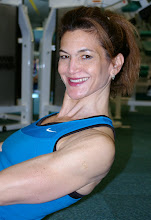"Did you warm-up?" I repeat these words all day long as a personal trainer. I tell my clients that I will not touch you if you don't. But what is the proper way to warm-up?
The latest research promotes Dynamic Stretching after getting your heart rate up. I have summarized it below. The information was taken from an article in the New York Times, Sports Magazine on Oct 31, 2008.
A well-designed warm-up starts by increasing body heat and blood flow. Warm muscles and dilated blood vessels pull oxygen from the bloodstream more efficiently and use stored muscle fuel more effectively. They also withstand loads better. To raise the body’s temperature, a warm-up must begin with aerobic activity, usually light jogging. Most experts advise starting your warm-up jog at about 40 percent of your maximum heart rate (a very easy pace) and progressing to about 60 percent. The aerobic warm-up should take only 5 to 10 minutes, with a 5-minute recovery.
While static stretching is still almost universally practiced among amateur athletes — watch your child’s soccer team next weekend — it doesn't improve the muscles’ ability to perform with more power, physiologists now agree. “You may feel as if you’re able to stretch farther after holding a stretch for 30 seconds,” McHugh says, “so you think you’ve increased that muscle’s readiness.” But typically you’ve increased only your mental tolerance for the discomfort of the stretch. The muscle is actually weaker.
Stretching muscles while moving, on the other hand, a technique known as dynamic stretching or dynamic warm-ups, increases power, flexibility and range of motion. Muscles in motion don’t experience that insidious inhibitory response. They instead get what McHugh calls “an excitatory message” to perform.
Dynamic stretching is at its most effective when it’s relatively sports specific. “You need range-of-motion exercises that activate all of the joints and connective tissue that will be needed for the task ahead,” says Terrence Mahon, a coach with Team Running USA, home to the Olympic marathoners Ryan Hall and Deena Kastor.
Here are the three best Dynamic Stretches. These are to be done after you get your heart rate up: (Go to the link listed above for pictures of the three exercises)
1. STRAIGHT-LEG MARCH
(for the hamstrings and gluteus muscles)
Kick one leg straight out in front of you, with your toes flexed toward the sky. Reach your opposite arm to the upturned toes. Drop the leg and repeat with the opposite limbs. Continue the sequence for at least six or seven repetitions.
2. SCORPION
(for the lower back, hip flexors and gluteus muscles)
Lie on your stomach, with your arms outstretched and your feet flexed so that only your toes are touching the ground. Kick your right foot toward your left arm, then kick your left foot toward your right arm. Since this is an advanced exercise, begin slowly, and repeat up to 12 times.
3. HANDWALKS
(for the shoulders, core muscles, and hamstrings)
Stand straight, with your legs together. Bend over until both hands are flat on the ground. “Walk” with your hands forward until your back is almost extended. Keeping your legs straight, inch your feet toward your hands, then walk your hands forward again. Repeat five or six times.
As a trainer that likes to stay up-to-date and on the cutting edge, I will ask my clients to do these three dynamic stretches at the beginning of their workouts.
I will be incorporating these three dynamic stretches into all of my client's workouts. Please feel free to mimic us if you too want to practice the safest and most effective way to warm-up!
Ellen Yates
Personal Trainer
N2SHAPE, Inc.
www.n2shape.com
(703)9064413
Tuesday, November 4, 2008
Subscribe to:
Post Comments (Atom)

2 comments:
The last "hand-walk" is something Dave actually used to incorporate into the an-aerobic session of the workouts. He called it the "InchWorm" instead, since it mimics the movements of a worm.
It's fun.. but not towards the end of an anaerobic session when your muscles are absolutely fatigued!
That is why you are supposed to do it at the beginning of the workout I suppose.
Post a Comment